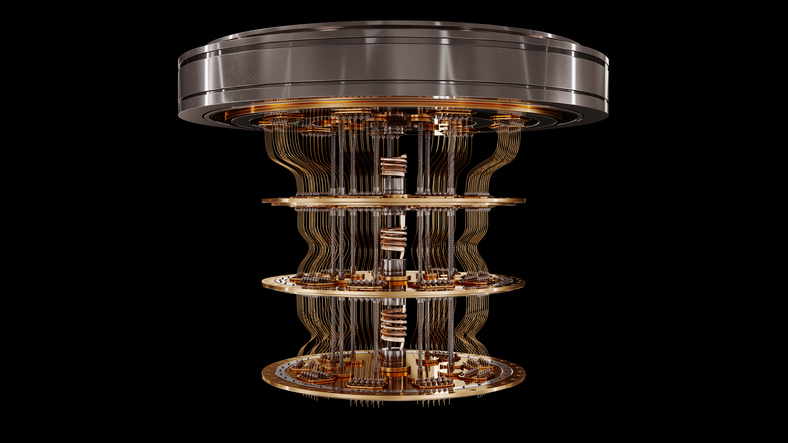AN INTRODUCTION TO QUANTUM COMPUTING
February 15, 2023

Quantum computing is an emerging field of computer science that seeks to harness the principles of quantum mechanics to solve computational problems. Unlike classical computing, which relies on bits that can be either 0 or 1, quantum computing uses quantum bits, or qubits, which can exist in multiple states simultaneously. This property of qubits, known as superposition, allows quantum computers to process and store much more information than classical computers.
Quantum computing has the potential to revolutionize the way we approach complex computational problems, such as cryptography, simulation, and optimization. By leveraging the unique properties of quantum mechanics, quantum computers can perform certain calculations much faster and more efficiently than classical computers.
Despite the tremendous potential of quantum computing, it is still a relatively new field and there are many technical and scientific challenges that must be overcome before quantum computers can be deployed in a practical setting. Nevertheless, advances in quantum computing are happening rapidly, and researchers and developers around the world are working to build a new generation of quantum computers that can solve the world’s most pressing computational problems.
Below are some of the important characteristics of Quantum Computing.
Qubits and Superposition
To introduce the subject, quantum information includes data for quantum states, which are used for computational manipulation in the study of quantum mechanics. These quantum bits are the computational equivalent to regular bits, and provide the fundamental units of information for quantum computing. The qubit is basically a 2-dimensional vector in the Hilbert space – which means it is described by two different states. One of these states is 0 and the other one 1. As opposed to a traditional bit that can only be in one of 2 states (0 or 1), a qubit has two ground states: |0 and |1. The storage capacity of a typical computer’s two-bit register is limited to only four binary configurations – 00, 01, 10 or 11. However, the same two-qubit register can store all the four values at once since each qubit holds two values instead of just one.
A qubit has the ability to simultaneously hold multiple states. This is the first quantum property we can discuss in detail. Superposition provides significant speedups to processing time and memories in quantum computers which makes them more efficient .The state of a qubit can be represented by a vector in the (usually) two-dimensional Hilbert Space. The qubit is represented by the perpendicular distance from an axis which is chosen in some way. One possible choice would be to choose the z-axis, because it connects all points in space, and there are no other axes that are orthogonal to it. A second possibility would be to choose the x-axis, because it is the only axis that goes through two points on the same plane, and there are no other axes that are orthogonal to it. .To clarify the difference between a qubit and a bit, consider the mathematical structure of a bit. A bit is represented by an x-y coordinate in the plane (more specifically, it’s x and y values). The z-axis is perpendicular to this plane. The Hilbert Space is then represented by three axes: the z-axis which connects every point in space; the x-axis which goes through two points on one line; and then there’s another axis that goes through two other points on one line. This means any point on this line could be considered as 0 or 1 at any given time.
Quantum Registers
Quantum registers are a fundamental building block of quantum computers. They are used to store and manipulate quantum information, which is stored in quantum bits or qubits. A quantum register is similar to a classical register in that it stores a sequence of bits, but the bits in a quantum register can be in a superposition of states.
A quantum register is usually represented by a vector of complex numbers, where each complex number represents the amplitude of a particular quantum state. The quantum states of the register are manipulated using quantum gates, which are unitary operations that preserve the normalization of the state vector.
Quantum registers can be used to store and manipulate quantum information in a variety of ways. For example, a quantum register can be used to represent a quantum state, to perform quantum algorithms, or to encode classical information in a quantum format.
Quantum Gates
Quantum gates are the basic building blocks of quantum algorithms and quantum circuits. They are the equivalent of logic gates in classical computing and perform operations on quantum bits, or qubits.
Quantum gates are unitary operations that manipulate the state of a qubit and cause a change in the quantum state of the system. Some common quantum gates include the Hadamard gate, the Pauli-X gate, the Pauli-Y gate, the Pauli-Z gate, and the CNOT gate.
The Hadamard gate is a unitary operation that transforms a qubit from the computational basis state |0> to the superposition state (|0> + |1>)/√2, and vice versa.
The Pauli-X, Pauli-Y, and Pauli-Z gates are three distinct single-qubit gates that operate on the X, Y, and Z components of a qubit’s state vector, respectively.
The CNOT gate is a two-qubit gate that operates on a control qubit and a target qubit. If the control qubit is in state |1>, the CNOT gate applies the NOT operation to the target qubit, flipping its state from |0> to |1>, or vice versa.
Quantum gates are used to perform complex quantum operations, such as quantum teleportation, quantum error correction, and quantum cryptography. They are also used to build quantum circuits, which are sequences of gates that perform specific quantum algorithms.
Quantum Entanglement
Quantum entanglement is a fundamental concept in quantum mechanics that describes a strong correlation between two or more quantum systems. When two or more quantum systems are entangled, the state of each system cannot be described independently of the state of the others. Instead, the state of each system is dependent on the state of the others.
In simple terms, entangled particles are connected in such a way that the state of one particle is dependent on the state of the other particle, regardless of the distance between them. This correlation is known as “spooky action at a distance” and was first described by Albert Einstein, Boris Podolsky, and Nathan Rosen in 1935.
Entanglement is a result of the superposition principle, which states that a quantum system can exist in multiple states at the same time. When two or more quantum systems are entangled, their superpositions become correlated, and the state of each system is dependent on the state of the others.
Entanglement has several important implications in quantum computing and quantum communication. For example, entangled particles can be used to transmit quantum information over large distances. Additionally, entangled particles can be used to build quantum algorithms that are faster and more efficient than their classical counterparts.
Developing Quantum Code
Developers looking to write code for quantum computing in .NET, can use the Microsoft Quantum Development Kit, which provides libraries, tools, and samples for developing quantum applications in .NET Core. The kit includes a library for quantum computing and ancillary technologies like quantum chemistry, cryptography, and machine learning. You can write quantum applications using C# or F#, which can be executed on a simulator or on a real quantum computer.
Here is a simple Q# code that implements the Deutsch-Jozsa algorithm, which is a quantum algorithm used to determine whether a function is constant or balanced. The algorithm takes an input function and returns “Constant” or “Balanced” based on the function’s behavior.
operation DeutschJozsaAlgorithm (f : (Qubit => Unit is Adj+Ctl)) : String {
using (qubits = Qubit[2]) {
H(qubits[0]);
X(qubits[1]);
H(qubits[1]);
f(qubits[0]);
H(qubits[0]);
if (M(qubits[0]) == One) {
return “Balanced”;
}
else {
return “Constant”;
}
}
}
In this code above, f is the input function, which is passed as an argument. The H and X gates are used to prepare the initial state of the qubits, and the M gate is used to measure the final state of the qubits. Based on the measurement result, the code returns either “Constant” or “Balanced”.
The Future
The future of quantum computing is both exciting and uncertain. On one hand, quantum computing has the potential to solve problems that are beyond the reach of classical computers, such as simulating quantum systems, breaking encryption codes, and solving optimization problems. This could lead to a wide range of scientific and technological advancements in fields such as cryptography, chemistry, and materials science.
On the other hand, quantum computing is still in its infancy and there are many technical and scientific challenges that must be overcome before it can reach its full potential. These challenges include improving the reliability and stability of quantum systems, developing robust and scalable quantum algorithms, and building the necessary infrastructure to support large-scale quantum computing.
Despite these challenges, there is a growing consensus among experts in the field that quantum computing will play a major role in shaping the future of computing. With further advancements, quantum computers could be used to solve problems in fields such as cryptography, chemistry, finance, and artificial intelligence. In the coming years, we can expect to see continued investment and research in quantum computing, as well as the development of new quantum algorithms and applications.

 English | EN
English | EN 